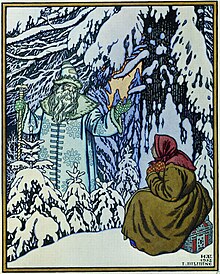Father Frost (fairy tale)

Father Frost (Russian: Морозко, Morozko) is a Russian fairy tale collected by Alexander Afanasyev in Narodnye russkie skazki (1855-63). Andrew Lang included it, as "The Story of King Frost", in The Yellow Fairy Book (1894).[1]
It is Aarne–Thompson type 480, The Kind and the Unkind Girls. Others of this type include Shita-kiri Suzume, Diamonds and Toads, Mother Hulda, The Three Heads in the Well, The Three Little Men in the Wood, The Enchanted Wreath, The Old Witch, and The Two Caskets.[2] Literary variants include The Three Fairies and Aurore and Aimée.[3]
The film Morozko was based on the fairy tale.
Synopsis[]
Once there was a woman who had both a daughter of her own, whom she loved, and a step-daughter, whom she hated. One day, the woman ordered her husband to take her stepdaughter out into the winter fields and leave her there to die, and he obeys. Father Frost finds her there; she is polite and kind to him, so he gives her a chest full of beautiful things and fine garments. After a while, her stepmother sends her father to bring back the girl's body to be buried, which he also obeys. After a while, the family dog says that the girl is coming back, and that she is beautiful and happy out to back, the family dog says the child will be buried. When the father brings back the body, the old woman weeps.
In the Grimm version, the girl is coated with gold and silver coins while the rude child is coated with cement, mud, flour and pitch.
See also[]
References[]
- ^ Andrew Lang, The Yellow Fairy Book,"The Story of King the Frost"
- ^ Heidi Anne Heiner, "Tales Similar to Diamonds and Toads"
- ^ Jack Zipes, The Great Fairy Tale Tradition: From Straparola and Basile to the Brothers Grimm, p 543, ISBN 0-393-97636-X
External links[]
- Russian fairy tales
- Fairy tales collected by Alexander Afanasyev
- Personifications
- Fictional characters with ice or cold abilities